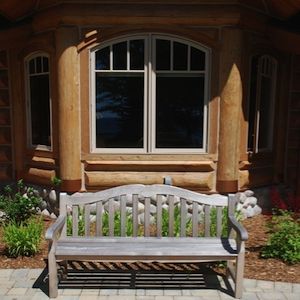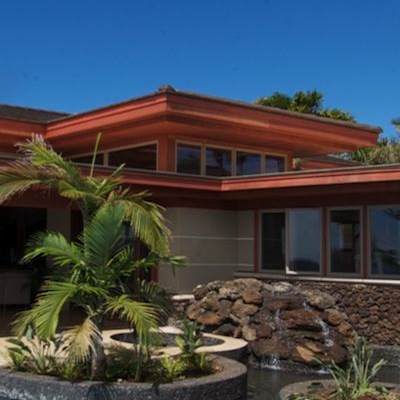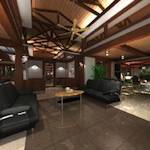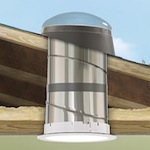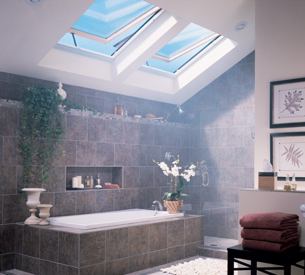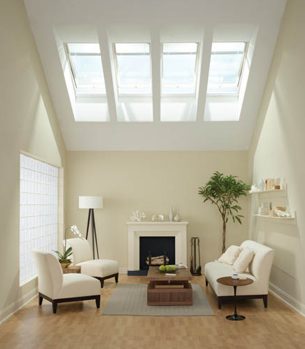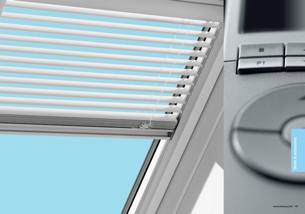Passive Solar Design
When designing a new green home, one of the best things you can do is take advantage of the passive solar elements that are available to you. You can simply and economically bring natural daylighting and solar heating into your home by just making some well-informed decisions.
How Does Passive Solar Work?
Designing a home to take advantage of its environment is a very important task and one that every homeowner should consider.
By designing a home to co-exist with the natural amenities of the site, your home becomes very organic and one with the site. This means you will save considerably on utility bills, have a very comfortable home to live in, and provide a healthy atmosphere in which to raise a family.
There are a lot of things to consider when designing passively, and you should know which are most important for your home and site. Find out more on this in our article, How Does Passive Solar Work.
Roof Overhangs:
By carefully analyzing the distance your home overhangs extend beyond the exterior wall, you can govern the shading factor you will be giving your walls, windows and sunrooms. The power of the sun can be a two-edged sword; the sun's energy is great in the winter, but not so great in the heat of summer.
Therefore, the design of your home's roof overhangs plays an extremely important role in controlling the power of the sun. Find out how this works, how it applies to your home, and how to calculate the beneficial size of Roof Overhangs in your particular area.
Clerestory Windows:
Clerestory windows are more trouble-free than skylights, can be very effective design elements, and are very effective in supplying your home with some of the best passive cross-ventilation available.
Learn everything you need to know about Clerestory Windows in this informative and fact-filled article.
Energy Star Windows:
When you are selecting your windows for a new home or a retrofit, you should shop for the best, most energy efficient windows you can afford because windows are typically one of a homes' greatest energy hogs.
The good news is that the Department of Energy (DOE), has developed a rating standard that allows the homeowner to realistically compare windows efficiency by the use of the Energy Star rating system. Find out what to look for in Energy-Efficient Windows, how much efficiency is realistic and how to make an well-informed decision on selecting windows in your area of the country.
Solar Tubes:
Do you have some hard to reach dark areas in your home where you would love to have some natural daylighting? These areas can be closets, bathrooms, storage rooms or other windowless rooms that normally rely on artificial lighting sources to illuminate.
Consider installing solar tubes in these areas. They are inexpensive, bring in vast amounts of light (some equivalent to a 700 watt incandescent light bulb), and are easy to install.
They are also relatively trouble-free and very adaptable to a retrofit. Visit the article on Solar Tubes to find out about these great green natural lighting solutions.
Roof Windows:
Isn't a roof window just another name for a skylight? Not really. Roof windows differ from skylights in that they are really a window that is installed on the roof. The biggest difference:t a roof window has an operable component (it can be opened and closed), which is very different from a skylight.
This is not new technology and the engineering used for the design of Roof Windows is very impressive and you can use them with confidence. Like clerestory windows, they bring natural daylight and passive ventilation into the core areas of the home.
Refer to the article on Roof Windows to learn more about these great devices you can add to your green home design. For additional information about controlling the power of the sun, refer to the articles Skylight Blinds and Skylight Shades, which are great automatic shading devices that give you hands-free operation of your sun control.
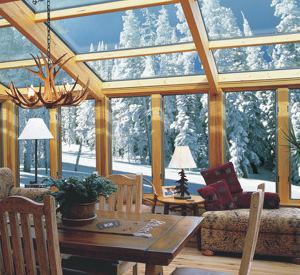
Sun Room Designs
Sun Room Designs:
Whether you call it a Sun Room, a Conservatory, or a 4-Season Room, they all point to the same design element, with minor design differences, that are some of the most treasured rooms you can add to a green home.
Sun Rooms come in many different styles, such as site-built units that your builder builds on site, prefabricated wood and aluminum units, and vinyl prefabricated units.
We will cover design elements of these great spaces, how they should be placed or added to your home, energy facts and much more. Stay tuned for our upcoming articles on Sun Room Designs and Conservatory Design.
Skylight Windows:
Skylights have been used for decades as a quality element to flood interior spaces with natural daylighting. Unfortunately they have also been associated with leaking issues and have fallen out of favor with many homeowners.
The good news is that with recent technological changes, skylights are now a very viable option for you to consider as a great green element in your home. Flashings are high performance, and installation methods have all but eliminated any problems you will have with these great devices.
Refer to the articles Skylight Windows, and Residential Skylights, for additional information on these units.
Skylight Shades:
As wonderful as skylights and roof windows are for bringing natural lighting, passive solar heat and ventilation into our homes, there are times when we really do need to control the amount of sun and light that we allow into our spaces.
Both shades and blind options are available for both skylight and roof windows, which will give you the ultimate in flexibility with these great devices and you can even program them to open and shut at pre-programed times and days
Refer to the article Skylight Shades, for additional information on these devices.
comments powered by Disqus






















































































































































































